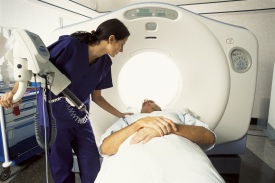Laryngeal Cancer: Tests After Diagnosis
Laryngeal Cancer: Tests After Diagnosis
What tests might I have after being diagnosed?
After a diagnosis of laryngeal cancer, you will likely have other tests. These tests help your healthcare providers learn more about your cancer. They can help show if the cancer has grown into nearby areas or spread to other parts of your body. The test results help your healthcare providers decide the best ways to treat the cancer. If you have any questions about these or other tests, be sure to talk with your healthcare team.
Some of the tests used after diagnosis may have also been used to find and diagnose the cancer. The tests you may have can include:
Chest X-ray
CT scan
Positron-emission tomography (PET) scan
MRI
Ultrasound
Bone scan
Imaging Tests
Chest X-ray
This X-ray may be done to see if the cancer has spread to your lungs.
CT scan
In this test, an X-ray beam takes a series of pictures of the inside of your body from many angles. These images are then combined by a computer, giving a detailed, 3-D picture of your body. CT scans can be used to determine the size of the tumor and find out if it has spread to nearby tissues or lymph nodes.
PET scan
A PET scan can look at your entire body. For this test, a mildly radioactive substance is injected into your vein. Then a machine takes pictures that show where in your body the substance is being used the most. These areas may be cancer. Some newer machines can do PET and CT scans at the same time. This allows areas that show up on the PET scan to be compared to the more detailed image of the CT scan.
MRI
This test uses radio waves, large magnets, and a computer to make detailed pictures of the inside of your body. It may be used to look for cancer that's spread to your neck.
Ultrasound
This test may be used to look for swollen lymph nodes in your neck, which can be a sign of cancer spread. It can also look for cancer that may have spread to your liver.
Bone scan
For this test, a small amount of a mildly radioactive substance is injected into your veins. This substance travels through your bloodstream and collects in areas of abnormal bone growth. A machine scans your body for the places where the substance has collected. These may be areas where the cancer has spread to the bones.
Working with your healthcare provider
Your healthcare provider will talk with you about which tests you'll have. Make sure to get ready for the tests as instructed. Ask questions and talk about any concerns you have.
Updated:
July 05, 2018
Reviewed By:
Gersten, Todd, MD,Stump-Sutliff, Kim, RN, MSN, AOCNS
